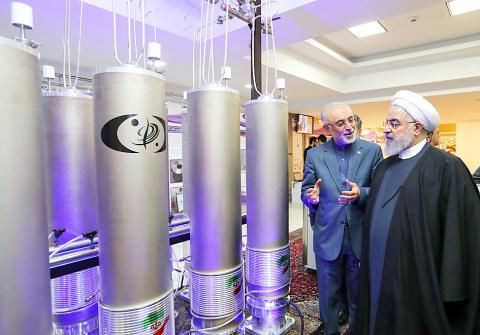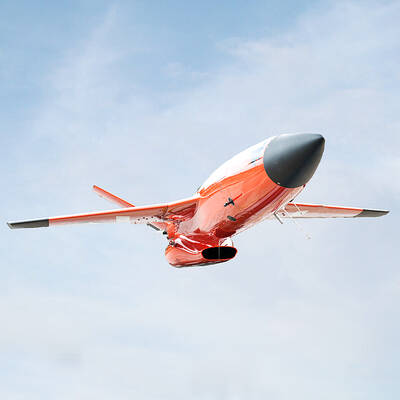Iran is tomorrow to announce details of a new cut to its commitments under a 2015 nuclear deal in response to sweeping US sanctions, the Iranian Students’ News Agency reported yesterday.
Atomic Energy Organization of Iran spokesman Behrouz Kamalvandi is to hold a news conference to set out the details of Iran’s third cut to its nuclear commitments since May, it said.
Iranian President Hassan Rouhani on Wednesday said that the steps included abandoning all limits set by the 2015 deal to Iran’s nuclear research and development.

Photo: AFP / Iranian Presidential Office
He spoke of “expansions in the field of research and development, centrifuges, different types of new centrifuges and whatever we need for enrichment,” but did not elaborate.
Iran and three European countries — Britain, France and Germany — have been engaged in talks to try to save the nuclear deal that has been unraveling since US President Donald Trump withdrew from it in May last year and unilaterally reimposed sanctions.
Rouhani earlier on Wednesday told a Cabinet meeting: “I don’t think that ... we will reach a deal.”
However, he had also said that Tehran and the European powers had been getting closer to an agreement.
“If we had 20 issues of disagreement with the Europeans in the past, today there are three issues,” he said.
Iran has expressed mounting frustration at Europe’s failure to offset the effect of renewed US sanctions in return for its continued compliance with the agreement.
It had already hit back twice with countermeasures in response to the US withdrawal from the deal.
On July 1, Iran said that it had increased its stockpile of enriched uranium to beyond the 300kg maximum set by the agreement. A week later, it announced it had exceeded a 3.67 percent cap on the purity of its uranium stocks.
The UN International Atomic Energy Agency on Friday last week said that Iran’s uranium stockpile stood at about 360kg and that just more than 10 percent of it was enriched to 4.5 percent.
Rouhani has stressed that the countermeasures are all readily reversible if the remaining parties to the deal honor their undertakings to provide sanctions relief.
A senior US official on Wednesday ruled out any exemptions from Iran sanctions to permit a French-proposed credit line, which Tehran says could bring it back to full compliance with the deal.
“We can’t make it any more clear that we are committed to this campaign of maximum pressure and we are not looking to grant any exceptions or waivers,” US Special Representative for Iran Brian Hook told reporters.
On Wednesday, the US issued its third set of sanctions on Iran in less than a week.
In the latest salvo, the US Department of the Treasury blacklisted a shipping network of 16 entities, 10 people and 11 vessels that it said was selling oil on behalf of Iran’s elite Revolutionary Guards’ Qods Force.
The network sold more than US$500 million of oil this spring, mostly to Syria, benefiting Syrian President Bashar al-Assad and militant Lebanese allies Hezbollah, the department said.

CROSS-STRAIT COLLABORATION: The new KMT chairwoman expressed interest in meeting the Chinese president from the start, but she’ll have to pay to get in Beijing allegedly agreed to let Chinese Nationalist Party (KMT) Chairwoman Cheng Li-wun (鄭麗文) meet with Chinese President Xi Jinping (習近平) around the Lunar New Year holiday next year on three conditions, including that the KMT block Taiwan’s arms purchases, a source said yesterday. Cheng has expressed interest in meeting Xi since she won the KMT’s chairmanship election in October. A source, speaking on condition of anonymity, said a consensus on a meeting was allegedly reached after two KMT vice chairmen visited China’s Taiwan Affairs Office Director Song Tao (宋濤) in China last month. Beijing allegedly gave the KMT three conditions it had to

STAYING ALERT: China this week deployed its largest maritime show of force to date in the region, prompting concern in Taipei and Tokyo, which Beijing has brushed off Deterring conflict over Taiwan is a priority, the White House said in its National Security Strategy published yesterday, which also called on Japan and South Korea to increase their defense spending to help protect the first island chain. Taiwan is strategically positioned between Northeast and Southeast Asia, and provides direct access to the second island chain, with one-third of global shipping passing through the South China Sea, the report said. Given the implications for the US economy, along with Taiwan’s dominance in semiconductors, “deterring a conflict over Taiwan, ideally by preserving military overmatch, is a priority,” it said. However, the strategy also reiterated

‘BALANCE OF POWER’: Hegseth said that the US did not want to ‘strangle’ China, but to ensure that none of Washington’s allies would be vulnerable to military aggression Washington has no intention of changing the “status quo” in the Taiwan Strait, US Secretary of Defense Pete Hegseth said on Saturday, adding that one of the US military’s main priorities is to deter China “through strength, not through confrontation.” Speaking at the annual Reagan National Defense Forum in Simi Valley, California, Hegseth outlined the US Department of Defense’s priorities under US President Donald Trump. “First, defending the US homeland and our hemisphere. Second, deterring China through strength, not confrontation. Third, increased burden sharing for us, allies and partners. And fourth, supercharging the US defense industrial base,” he said. US-China relations under

The Chien Feng IV (勁蜂, Mighty Hornet) loitering munition is on track to enter flight tests next month in connection with potential adoption by Taiwanese and US armed forces, a government source said yesterday. The kamikaze drone, which boasts a range of 1,000km, debuted at the Taipei Aerospace and Defense Technology Exhibition in September, the official said on condition of anonymity. The Chungshan Institute of Science and Technology and US-based Kratos Defense jointly developed the platform by leveraging the engine and airframe of the latter’s MQM-178 Firejet target drone, they said. The uncrewed aerial vehicle is designed to utilize an artificial intelligence computer